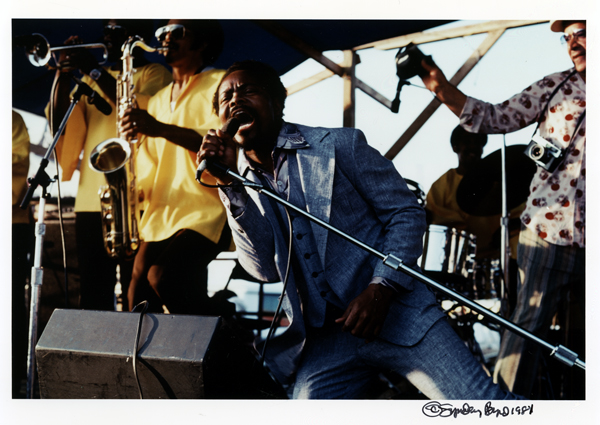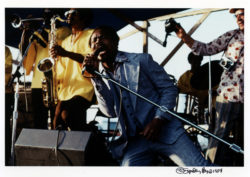Ernie K-Doe
The late New Orleans rhythm & blues artist Ernie K-Doe remains an iconic figure in Crescent City music and culture.

Courtesy of Louisiana State Museum
Ernie K-Doe. Byrd, Syndey (Photographer)
The late New Orleans rhythm and blues artist Ernie K-Doe stands as a multifaceted icon in Crescent City music and culture. Known for his flamboyant, egotistical personality, he recorded a string of first-rate R&B songs from the late 1950s through the mid-1960s. His best-known hit, “Mother-In-Law,” topped Billboard’s pop and R&B charts in May 1961.
Born Ernest Kador Jr. (the phoneticized name, K-Doe, was devised by the also-phoneticized Minit record company) on February 22, 1936, the performer would often brag that he was a “Charity Hospital baby,” delivered at New Orleans’s large public infirmary. K-Doe was raised in New Orleans and spent significant periods of his childhood in Baton Rouge and Pointe Coupee Parish. The son of a Baptist preacher, K-Doe started out singing gospel music but soon switched to the secular side.
In addition to “Mother-In-Law,” K-Doe’s other hits from his professional peak—including “A Certain Girl,” “Hello, My Lover,” “T’aint It the Truth,” and “Te Ta Te Ta Ta”—remain perennial regional favorites decades after their release; Gulf Coast bands are still expected to be able to play these songs upon request. Collectively, this work established K-Doe’s reputation—and his legacy—as an expert, top-tier R&B singer, a deservedly respected peer of such greats as Fats Domino, Smiley Lewis, Irma Thomas, Aaron Neville, Shirley and Lee, and Clarence “Frogman” Henry, among others in the New Orleans pantheon. These records also helped establish the reputation of Allen Toussaint, who played on, produced, and arranged them; Toussint wrote many of K-Doe’s songs as well.
In addition to his mainstream commercial success, K-Doe remains posthumously beloved due to a grandiose persona that was excessive even by New Orleans’s extremely generous standards. Although K-Doe’s heady phase as a chart-topping star ended by the mid–1960s, he felt sure that another big hit would materialize. As time passed and this didn’t happen, the growing frustration propelled K-Doe into chronic, long-term alcoholism. But even after two decades of hard living, low-level gigs, and low-selling records, K-Doe determinedly stayed poised for his next big break; he never considered quitting music to get a day job.
K-Doe’s profile rose again in the early 1980s when he hosted a show on WWOZ-FM, a community radio station in New Orleans. In the 1960s, K-Doe had projected the image and demeanor of an essentially conventional R&B singer. At this point, however, he no longer carried himself as a suave, successful professional; to the contrary, although still an astute and charismatic musician, K-Doe had become somewhat unhinged. The “Ernie K-Doe Show” primarily found him playing his old records while screaming over them about his sheer genius. His live broadcasts would include such memorable statements as “Whoever think they can beat me dancing, beat me singing, doin’ splits, kickin’ the microphone, rollin’ off them stages, making them women tear my clothes off—come see me now ’cause the boy-child ain’t been born yet!” or “I’m leading the people of New Orleans out of bondage, just like Moses led the Hebrew children out of Egypt. The Pope couldn’t do it, Martin Luther King couldn’t do it, the Mayor can’t do it, but I’M GOING TO DO IT!” The (ultimately immodest) “Ernie K-Doe, how great thou art!” was also exclaimed. K-Doe’s frequent expression—“Burn, K-Doe, burn!”—became his unofficial slogan.
Fans of the “Ernie K-Doe Show” often recorded the program as it aired, spawning a cottage industry of sorts, as aficionados used pre-Internet technology to mail cassette copies around the world. As a result, K-Doe garnered an international cult following as an eccentric cultural icon and a figurehead of New Orleans’s grassroots surrealism. Even so, WWOZ canceled his show around 1987. K-Doe took such rejection hard, spiraling further downward into the life of a homeless derelict. He seemed destined to die in the gutter. At this critical juncture, however, K-Doe was saved by love, when he reconnected with his old friend Antoinette Dorsey Fox, who got K-Doe to significantly cut back on his drinking. Their relationship, initially professional and platonic, eventually blossomed into romance. In 1995 the entrepreneurial Fox opened up the Mother-In-Law Lounge, so that K-Doe—who had justifiably acquired a reputation for unreliability among New Orleans club owners—would always have a performance venue. The two wed in 1996.
Dried out and set up in his own club, K-Doe underwent a significant career resurgence. In 1998 he proclaimed himself “the Emperor of the Universe” and began dressing the part in regal robes, a cape, and a crown. The Mother-In-Law Lounge became the premier funky-but-chic nightspot in New Orleans, drawing a vastly diverse clientele who all got along famously. In 1999 K-Doe performed for an audience of 60,000 at the foot of the Washington Monument as part of a Fourth of July concert broadcast on National Public Radio. The year 2000 found him acting in the independent feature film, Happy Here and Now, which was released after his death. In 2001 K-Doe rode as the king of the annual Mardi Gras parade of the Krewe du Vieux. At the time of his death, K-Doe’s career was on a dramatic upswing.
K-Doe died on July 5, 2001. After he lay in state at Gallier Hall, an honor reserved for the most notable of New Orleanians, one of the city’s largest jazz funerals snaked its way to St. Louis Cemetery No. 1. Shortly afterward, Antoinette K-Doe commissioned a lifelike statue of K-Doe that was fashioned from a department store mannequin; the statue became a New Orleans celebrity in its own right. Antoinette also kept the Mother-In-Law Lounge open and as popular as ever, until her death on Mardi Gras Day 2009. The club closed in December 2010, but it is slated to be reopened by the popular New Orleans trumpeter Kermit Ruffins.
